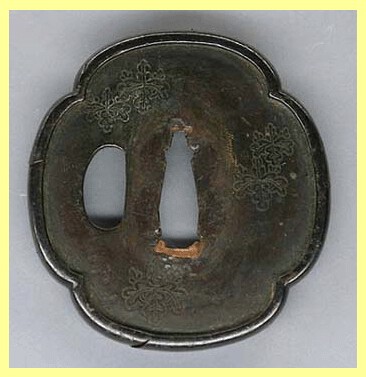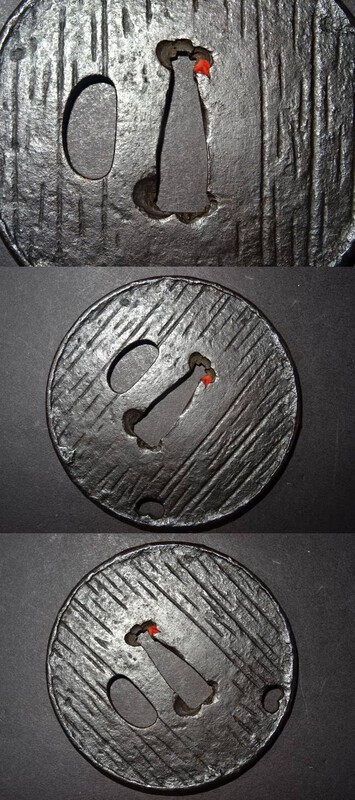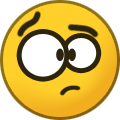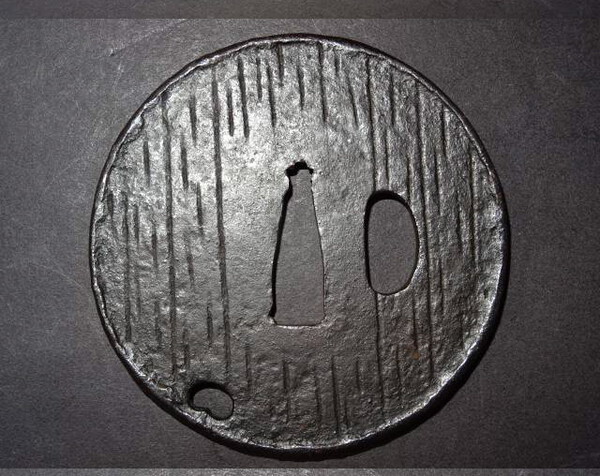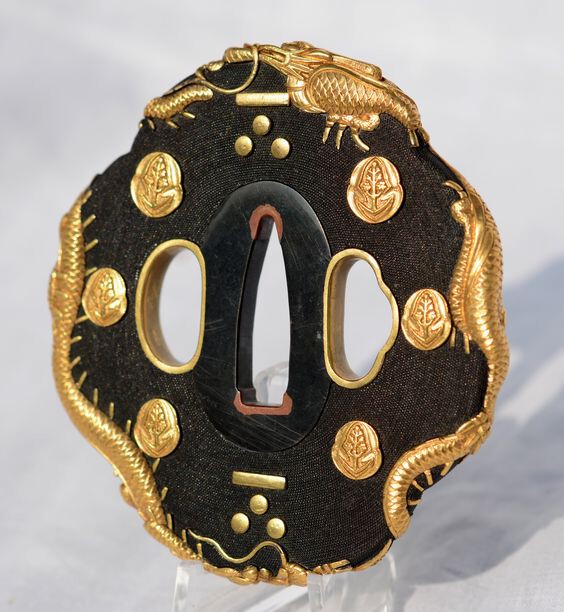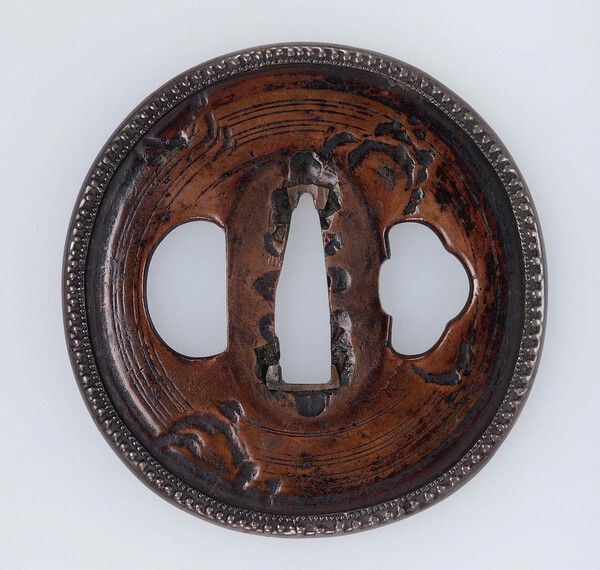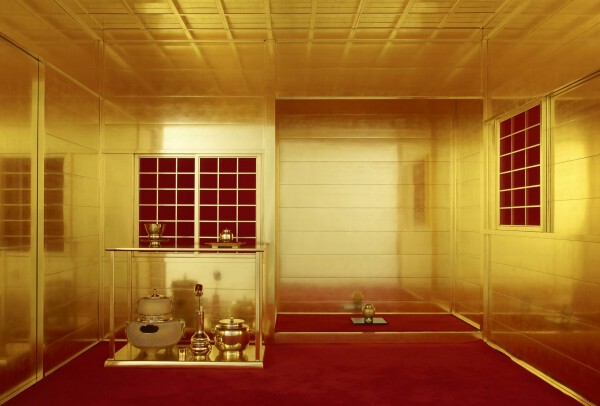-
Posts
962 -
Joined
-
Last visited
-
Days Won
4
Content Type
Profiles
Forums
Events
Store
Downloads
Gallery
Everything posted by Steve Waszak
-
Ah, I see. Thanks, Curran, both for the good kantei test and the explanation here. I suppose it would help me to have the Hayashi book. Higo (and even more, Akasaka) are a bit outside my area of focus, but still, this was a great learning exercise. Thanks for posting. Cheers, Steve
-
Second set: first one is Hayashi Matashichi; the second, Hayashi Shigemitsu. ?
-
Oh Guido, Guido, Guido... Of course this is about taste. That's all it can be about. All the silly, sarcastic references you make to "real" samurai and "real" men, even if we were to take them at face value, would still boil down to conceptions of taste (i.e. aesthetic expressions "suitable" for such categories of individual). So it is, most assuredly, about taste. And your overstatement about the "sophisticated collector" just makes your post bombastic. Likewise your flaccid attempt to denigrate the appreciation of old iron via that inane reference to "slips of the hammer" and the Emperor's new clothes. Why don't you put your money where your mouth is and produce an example here of an early iron tsuba that you KNOW presents with "slips of the hammer" rather than any conscious effort to produce an effect associated with specific aesthetic principles. SHOW us a no-doubter EXAMPLE of a celebrated tsuba which is really an "Emperor's New Clothes" early iron sword guard. Be sure to turn off your shakuhachi music when you do it so your head will be clear, and you'll be free of any "romantic" demons that seek to cloud your judgment. Sheesh. What I'm tired of is smug individuals who denigrate early iron collectors' affinity for the aesthetic features present in those works and which features can be cogently argued to have been intended (*Note: just because YOU don't understand or like the argument doesn't mean it's not cogent). And just because you don't/can't understand elusive aesthetic principles does not mean others can't or don't, or that they don't have positive substance and meaning . Does your inability to see a clear curving of the earth at the horizon make you a flat-earther, too? I mean, why wouldn't it? You can't see a curve, so it can't be there. Your comment about "collecting art, and not romantic notions" is, of course, an elitist one. Surely you see this. And carried within this attitude is one of superiority over others. And with this comes the denigration---sorry, belittling---of others' ideas, perceptions, sensibilities. Surely you see this, too. So you must be deliberately contradicting yourself. An interesting approach; not really working very well for you, though. By the way, how did you get involved with collecting "samurai art," anyway? What was the psychology involved? Since we know there was no romance connected with it, what, exactly, constituted the appeal? To collect this kind of object is a remarkably odd choice for someone who won't stoop to "collect romantic notions." Finally, your plea for comparing apples with apples gets at the very root of the issue, which apparently you don't understand. The whole point is that there is no Edo kinko to compare to top-grade Momoyama iron (here I do include first-generation Higo, since they were effectively of a Momoyama sensibility, given the various contexts to be considered, especially that concerning Hosokawa Sansai). The two groups do not have "equal artistic qualities" because they do not have shared aesthetic sensibilities. This is the point. And seriously, Guido, I don't have to "belittle others' choices to make [mine] look better"; I am simply giving reasons for why I find Edo kinko to be of poor taste (yes, taste), even if the craftsmanship in some of these pieces is exquisite. But as you would say, if the shoe fits, wear it.
-
Well, I tried to stress that my views on Edo kinko are just my views, and that taste is an individual thing that is very difficult if not impossible to account for. And I started off "innocently" enough, though I did make the comment about Hideyoshi's over-the-top tea room. But really, George, if you hadn't introduced the "manhole covers," "old charcoal briquettes," and "Emperor's New Clothes" business in relation to old iron tsuba, I'd likely have not gotten into my personal views of Edo kinko. I find it ironic that you can state that "too often when proponents of iron extoll its virtue, they do so by putting down kinko and its proponents instead of simply talking about the values of iron," when it was you who really started this conversation in this direction by making the post you did (#18). To say that you think that "there are far too many collectors who are admiring the Emperor's New Clothes" is implying 1. that the tsuba in question are not deserving of this admiration; 2. that those who do admire such works are less than astute or are clearly not seeing things "correctly"; and that 3. you have the authority to determine which iron pieces are "manhole covers" and which are, in fact, legitimately good pieces. Sheesh. I'm still waiting for you to produce an example of an "old charcoal briquette" that would represent Emperor's New Clothes syndrome at work. I am very curious to see what early iron tsuba that others see as excellent is actually, according to you, one that is not worthy of such admiration/appreciation, and is in fact fooling those poor benighted collectors. Having said all of what I have, I am not intending to suggest that I think all or most iron tsuba are masterpieces. In my view, most are actually rather banal and ordinary works---serviceable and appealing enough, but not especially noteworthy, and not worthy of particular praise or appreciation (again, in my opinion). There are only a relative few that achieve the level of masterpiece, I would say. But I would also say that the very best iron tsuba (I mean here sword guards of the level of Nobuiye, Yamakichibei, Hoan, the Higo masters, etc...) are aesthetically superior to ANY Edo kinko tsuba. Why? Not because of any automatic technical superiority, necessarily (although the forged plates of such early iron masters are, I think, far more interesting and beautiful than the featureless plates of the majority of Edo kinko tsuba, a sentiment I know Dr. Torigoye would share in abundance), but because of the aesthetic sensibility and vision possessed by these early iron masters versus that of Edo kinko artists. An analogy I might draw here is between Noh and Kabuki theater. Kabuki, like Edo kinko, has broad appeal. It is popular. It is aimed at satisfying the masses. The lowest common denominator here is, well, low. Noh, on the other hand, requires a more educated audience to fully appreciate its nuances, allusions, and implications. It is subtle, layered, and yes, sophisticated. Yuugen, it may be argued, is the chief aesthetic principle/quality informing Noh theater. This same aesthetic value informs many of the great early iron tsuba (much as it did the Tea of Momoyama Japan, which is why it is necessary to study Tea in this period to understand the iron tsuba produced in that same period). It is not an aesthetic value to be found in Edo kinko. Does it make one/me an elitist to appreciate, embrace, and extoll the virtues of this value in early iron (Momoyama) tsuba, and to see other (Edo kinko) works as lesser? If so, I'm fine with that. I have no problem being an elitist. I actually like your term---jovial elitist. I think I shall adopt it. When we evaluate tsuba, we can of course assess the technical qualities of a given work, i.e. how well an artist has executed his vision and design. But evaluating merely the technical aspects is secondary at best. The primary consideration, I would argue, is the vision and design (that is, the aesthetic sensibility) itself. If an artist has a mediocre aesthetic sensibility, if his vision and design are second- or third-rate, how well he executes that vision/design becomes essentially irrelevant. And this is what you have with the huge majority of Edo kinko: third-rate aesthetic sensibility (see the Kabuki analogy above). So, sure, some of the technical aspects of these works are astounding, and the pieces can be "pretty," if one does not mind the treacly sentiment so many of them express. But for me, the greatness of the early (Momoyama) iron tsuba is in their combination of a deeply allusive and nuanced aesthetic sensibility with awesome technical achievement in the forging of the plate and their treatment of the plate (tsuchime, yakite, tekkotsu, jimon, patina, etc...), together with sensitively placed and rendered sukashi, nikubori, etc... The brilliant forming of the sugata, niku, rim, and other elements into a tactile, three-dimensional work of art completes a total package. It is the aesthetic sensibility, first and foremost, though, that matters. And as an elitist, I just don't see a high-level aesthetic sensibility in Edo kinko guards, with very, very few exceptions. Shrug. That's just how I see it.
-
Hi George, Well, I can agree with some things you offer here, but not others. I would certainly agree that kinko were used by bushi, and we can see from examples in Uchigatana no Koshirae, I believe, that soft-metal tsuba (yamagane, mostly, I think) were mounted on warriors' koshirae, at least sometimes. I don't find either of these points to be very debatable, really. Where I would not necessarily agree is that I'm "not being honest with [myself] if I can't agree that the Shomin kinko...is at least as good as [my] 'hard metal' example." The problem here is what you mean by "good." If by "good" you mean that the Shomin piece is as well made (i.e. technically executed) as the Yamakichibei guard here is, with that I can agree. Where I will certainly not agree is that the Shomin piece is anywhere near as tasteful (to use your term) as the Yamakichibei. I can't stand the Shomin tsuba. While I would not at all call it "gaudy," in my view, it is hopelessly saccharine, even mawkish, in presenting the subject it does (despite its technical excellence). The plate is bland, dull, featureless. The tsuba is utterly lacking in haki (power, ambition), an aesthetic value highly prized (in my sensibility of things). Then again, it's not trying to express this value. Which is perfectly fair: not all works need aim for the same aesthetic value/expression. But see, what we're really discussing here is taste, and as the saying goes, there is no accounting for taste. I can't say why I have always had (right from the beginning of my interest in this stuff) such a visceral dislike of all tsuba like this Shomin, or why I gravitate so strongly to the quiet iron guards, other than to say that certain Japanese aesthetic principles (yuugen, mono no aware, shubusa, sabi, including and especially haki) are vastly more appealing to me than others, and that some tsuba (such as many pre-Edo iron Owari works) satisfy this set of aesthetic principles/values far more effectively than other types of tsuba do, and this includes about 99.9% of Edo kinko. For me, a good deal of Edo kinko is akin to a ruby-studded gold Rolex in its aesthetic sensibility; even those Edo kinko tsuba which are not so flamboyantly bling-y are still often saddled with a dripping sentimentality that makes them (in my eyes) paragons of triteness. Is there anything inherently wrong with this? Maybe not, but the taste required to be drawn to such things is certainly not anything I've been blessed with. As for attempting to "persuade Chris by jovial elitism and embarrassment," remember, he came to us seeking help. If he is interested in expanding his taste, and learning what it is about some "manhole covers" that makes them great, and why so many are so celebrated by the Japanese, I am going to do what I can to help out.
-
Chris, In response to your query regarding masterpiece "wabi" koshirae, I can post this example here. I'm not sure I'd call it "wabi," exactly, but it certainly is spartan relative to many of the gaudy koshirae we are familiar with. This koshirae, incidentally, is juyo. Cheers, Steve
-
Oh, wait. Sorry. My mistake. This is an iron ita tsuba from the Momoyama Period made by nidai Yamakichibei, one of the most respected tsubako in Japanese history, an artist with a number of juyo tsuba to his name. Maybe there is more to appreciate here than first meets the eye...
-
-
Henry, I've always liked that ko-Kagamishi piece. A nice, quiet beauty... Chris, the best book on koshirae I've seen is Uchigatana no Koshirae. Spectacular examples of all kinds of koshirae here. Grey should be able to get you a copy. WELL worth it.
-
George, Would you please be so good as to supply a few photos of these "manhole covers" and "charcoal briquettes" for us? I'd very much like to see these "emperor's new clothes" examples. Thanks.
-
And it needs to be said, too, that there is kinko, and then there is kinko. While I would love to have one of the two tsuba pictured here, the other is wholly unappealing (this is being kind). Both are kinko, technically, but it is akin to saying that a Siberian tiger and a tabby are both felines. One of these tsuba exhibits forcefully a value Kokubo Ken'ichi called Haki (power, ambition, unbridled spirit), while the other is trite, obvious, unimaginative, and the very embodiment of insipidity (all in my humble opinion, of course... ). Which is which?
-
On the other hand, Kaneie was Hideyoshi's Fushimi tsubako, so he must have had some taste...
-
-
Hi Chris, I'm happy to help out if I can. Those who know me here will hear me go on and on about the virtues of pre-Edo iron, especially Azuchi-Momoyama Owari tsuba... So again, if you'd like to set up a time to talk in live time, just let me know. I'm in San Diego, so on USA west coast time. Just a thought or two to add quickly here. As concerns Tsuba: An Aesthetic Study, it was really the Introduction of the book that I found most rewarding, mostly because it confirmed/supported a viewpoint I'd long held: that it is the plate of the tsuba that matters first and foremost in a pieces's beauty, not any applied decoration, whether sukashi, carving, or inlay. The book is worth getting just to read this argument. Next, another "small" book on Japanese aesthetics is Donald Richie's A Tractate on Japanese Aesthetics. It is all of 79 pages, but it introduces and explains many aesthetic terms/concepts that were in use from the earliest centuries of Japanese history, on through the Muromachi, Momoyama, and Edo periods. The book Ford mentions, Tanizaki Jun'ichiro's In Praise of Shadows is one I not only echo in recommending, it's a book I quoted from rather liberally in an article I wrote on the importance of lighting in iron tsuba appreciation. I would second Henry's comment that for text, Sasano's gold book is the one to have, but for images, his silver book is a must-have. I should mention, too, that to really understand pre-Edo iron tsuba, you must also familiarize yourself with the Tea Ceremony and the articles used in that practice (the ceramics, in particular, for many of the aesthetic concerns attached to the Tea Ceremony (which was a hugely important cultural phenomenon of Momoyama and early Edo times) also informed the design and construction of upper-level iron guards. Contrary to what some might say, the finest of iron tsuba of those times were meant for high-ranking bushi, the same bushi who were also intimately involved with Tea. Finally, it's worth noting, I think, that the most celebrated tsubako of all time for the Japanese (generally speaking, of course) are Nobuiye and Kaneie, both of whom worked almost exclusively in iron and were Momoyama artists. Many will argue that these tsubako best expressed many of the most valued aesthetic principles of their age (or any) age. There is SO much more to say on this, Chris, so please do get in touch... Cheers, Steve
-
Hi Chris, Actually, I'd recommend Sasano's Early Japanese Sword Guards: Sukashi Tsuba as the best introductory text for appreciation of early iron guards. But I'd be more than happy to elaborate in detail on the merits of early iron tsuba... Please feel free to email me at stevewaszak@cox.net. We can get into lots of specifics. If necessary, we can arrange a phone call. Happy to help if I can... Steve
-
And, uh... What ever happened to the Buttweiler School pieces? Still floating around out there...with their papers? Wonder what else he made...
-
Thanks for this reminder, Pete: I do need to get a copy of this book. Don't know why I haven't up to now... I have had a few twisting, tortured experiences along the way! But none to top yours here. Alas, I haven't your resolve, Pete: I have fallen into the Pandora's box of ceramics, too... Hopeless and helpless I am...
-
Pete, Great story, congratulations on your "re-find," and thanks for posting the video. Really helps to bring these menuki to life!
-
Hi Ford, Sounds good, Ford. I look forward to that day very much... God knows what might come out of our mouths once the sake is flowing! Cheers, Steve
-
Hi Ford, Agree with pretty much all of what you say here except, perhaps, the bit concerning the hitsu-ana (a relatively minor point ). Your thoughts about the first tsuba being a better example of its type than the Kanayama is of its type (Kanayama) I wouldn't necessarily disagree with, either, though outside of the first one's being called a "tokei" tsuba, I'm not sure what type it is. I certainly concur that there are much better Kanayama guards than this one, and the price this piece carries ($2,500) is about the upper limit that it could/should command, in my view. It's a good Kanayama, but "good" is about all. Oh, and I need to add that if I left the impression that I thought both of these were Kanayama works, apologies: the first is not, of course, a Kanayama tsuba, and I never meant to suggest that I thought it was. And you're quite right, too, in saying that the two are not really comparable in that they each pursue different aesthetic goals (the shared motif is not really a point that should/needs to be compared). But if I were a bushi in need of a new guard for my koshirae, and was enamored with the "tokei" look, I'd definitely be choosing the Kanayama over the other, IF cost were not an obstacle. I can certainly accept the argument that the first tsuba represents a better value for the money, especially if a bit of TLC were applied, than the Kanayama would (for its type). I will hold that the Kanayama is the stronger tsuba if we are simply asking which tsuba I'd rather own, but when the question is presented as you do (which is the better buy for the money?), I don't see any discord in our thoughts... Cheers, Steve
-
A few thoughts to convey in response... First, as to what I mean by "stiff, dry, and lacking in vibrancy," what I'm trying to say is that, sometimes, we encounter pieces that lack subtlety in the fluidity of their lines (here I do not only mean the relatively two-dimensional lines of the top-down view of the tsuba's "face," but also the niku moving from seppa-dai to mimi, and "traveling" across the plate). The first tsuba you present appears to me to be lacking in this fluidity: there is little to no sensuousness to the form. It is rigid. Of course, this is in the eye of the beholder, so one's mileage may vary... The tsuba also presents (in this single photo) as lacking depth to any patina it may have; it lacks the "wetness" so prized among many old-iron tsuba connoisseurs. Again, I qualify this statement due to the fact that we are viewing these pieces through photos only, and in the case of the first one, a single rather poor image. It may be that, in hand, it does indeed have a deeper, richer patina than it appears to here. When a tsuba lacks both the "life" of a wet patina and is also lacking in fluidity/sensuousness of the forms that comprise it, then to me, it lacks vibrancy therefore. Tsuba #1 is thus dull, insipid, DOA... Ford, Oh come now... You know as well as I do that actually working with metal has nothing at all to do with whether one is "beguiled" by "lumpy bits in iron." Our response to such "bits" is based on aesthetic sensibilities, and is not related to experience at the bench. Further, whether there may be any certainty in how tekkotsu "may be explained or described" again has zero to do with appreciating their effect. And your separation of aesthetic value and market psychology is something of a false dichotomy: if one (or the market) values tekkotsu aesthetically, and enough sympathize with such a valuation, then the market will respond. Perhaps I'm not understanding what you mean by the distinction you're making exactly... As for your comment about tulips and the like, if your point is simply that tastes change, and that there is no accounting for taste (and the [market] values/valuations that accompany shifts in taste), well...yeah. There is no fixed and objective, intrinsic superiority of one form or another, whether in tsuba art or any other. What one considers superior to another depends on argument, not on fact. So I'm not quite sure what you meant to accomplish by including this comment. I find your thoughts as concerns tsuba #2 quite intriguing. As we all know, one cannot accurately assess surface presentation of tsuba via photos, so the statement you make about its state of preservation is curious and perplexing. Then, your qualifier---"apart from some obvious lumpiness in the rim"---in assessing the quality of the iron is frankly odd: you select out THE dominant aesthetic property of Kanayama guards and then evaluate the rest. I guess I might say that, apart from the engine, transmission, suspension, and chassis design, there isn't much special about ferraris. Sheesh. Further, by comparison, the metal of tsuba #1 appears (in the photo) to be utterly lacking in character, unless one finds rust patches to be "character building." And there is nothing at all "awkward and stiff" about the hitsu in tsuba #2---in fact, their placement so close to the edge of the plate creates a liveliness that, again, tsuba #1 wholly lacks. The hitsu-ana placement in tsuba #2 presents as carefully considered; by contrast, the hitsu-ana in tsuba #1 come across as rote, by-the-book, mindless. The price of this tsuba is fine. $2,500 for a good tsuba is nothing. Juyo-level Kanayama are $10K-plus. This piece isn't juyo, obviously, nor even TBH; but it is a good Momoyama Period Kanayama guard. There are not a lot of these around. If anyone thinks that a superb-quality Kanayama tsuba can be had for $2,500, he had better reconsider what counts as superb. For maybe the fifth time, I'll say that without seeing the tsuba in hand, I would reserve any sort of final judgment. But it is a superior rendering of the motif to that seen in tsuba #1, at least in the features I would value. Finally, oh I wish it were so that such "flash patination" could work such wonders. I have yet to see anything approaching a convincing patina in quick-fix (and even the vast [VAST] majority of slow-fix) cases. When one has seen deep, old patinas on fine iron, there is nothing that can compare. I am not suggesting here that tsuba #2 has such a patina; I rather doubt it, frankly (though again, I have only photos to look at). In any event, and in the end, it really boils down mostly to taste and what we find appealing. I personally loathe Edo Kinko as hopelessly trite, mawkish, saccharine (most of it), but that says everything about me, and virtually nothing about the pieces themselves. I think all we can do is try to assess how well an aimed-for aesthetic expression achieves those aims vis-a-vis others that also target that expression. And to my eye, tsuba #2 easily out-does tsuba #1, and it is a good, though not great, example of Kanayama sensibilities. Cheers, Steve
-
An interesting thread. Personally, I see #2 as far superior to #1. #2---a Momoyama Kanayama guard---is peppered with strong tekkotsu all over the rim (a highly desirable feature for those who like the Tea aesthetic), and, at 6mm thick, is a substantial tsuba, even at its otherwise smaller dimensions. It also appears to have a much better patina, though of course, such judgments always come with a caveat when they are made via photos, only. #1 to me appears stiff, dry, lacking the vibrancy that #2 has. I'm not a fan of the "tokei" motif, personally, but setting that aside, I can see why #2 would be valued at several times what #1 would be. Wakeidou's price (280,000 yen) actually makes sense to me ($5,000+ would not, however). Cheers, Steve
-
Shocking news. Very, very sad. Rest in peace, Thierry.
-

Umetada Myoju Tsuba
Steve Waszak replied to Thierry BERNARD's topic in Auctions and Online Sales or Sellers
That mei was scratched in the day before yesterday...with a paperclip. -
Thanks for that, Pete. Excellent.






